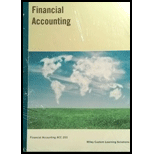
Concept explainers
Receivables
Receivables refer to an amount to be received in future. General classifications of receivables are
Accounts receivable
Accounts receivable refers to the amounts to be received within a short period from customers upon the sale of goods and services on account. In other words, accounts receivable are amounts customers owe to the business. Accounts receivable is an asset of a business.
Note receivable
Note receivable refers to a written promise by the debtor for the amounts to be received within a stipulated period of time. This written promise is issued by a debtor or borrower to the lender or creditor. Notes receivable is an asset of a business.
Other receivables
Other receivables such as interest receivables, loan to company officers, advances to employees, income taxes refundable are non-trade receivables as these are not resulted from sales transaction or business operations.
To prepare: A
Want to see the full answer?
Check out a sample textbook solution
Chapter 8 Solutions
FINANCIAL ACCOUNTING>IC<
- Please give me true answer this financial accounting questionarrow_forwardHello tutor please given General accounting question answer do fast and properly explain all answerarrow_forwardMonroe Enterprises had beginning total liabilities of $65,000 and ending total liabilities of $85,000. The beginning balance in stockholders' equity was $75,000. During the year, total assets increased by $50,000. In addition, capital stock of $20,000 was issued, and dividends of $10,000 were declared and paid. How much was Monroe’s net income for the year?arrow_forward
- Wayne Manufacturing estimates that overhead costs for the next year will be $4,200,000 for indirect labor and $540,000 for factory utilities. The company uses machine hours as its overhead allocation base. If 180,000 machine hours are planned for the next year, what is the company's plantwide overhead rate?arrow_forwardI need assistance with this financial accounting question using appropriate principles.arrow_forwardPlease show me how to solve this financial accounting problem using valid calculation techniques.arrow_forward
- Principles of Accounting Volume 1AccountingISBN:9781947172685Author:OpenStaxPublisher:OpenStax College
